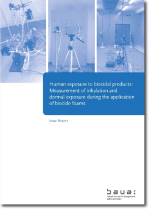Human exposure to biocidal products: Measurement of inhalation and dermal exposure during the application of biocide foams
At professional workplaces, biocidal products are applied by foaming techniques, among others. This project aimed at the development and assessment of a practical and easy-to-use assessment method, providing estimates of inhalation and dermal exposure towards non-volatile substances during foaming of biocidal products. The focus was set on the substance classes of pyrethroids and quaternary ammonium compounds (QACs) as two examples for non-volatile biocides which can be applied as either spray or foam.
The source strengths of the release of inhalable aerosols of the active substance and their deposition on surfaces were quantified in control chamber measurements carried out for representative foaming and spraying processes as well as biocidal formulations. The difference between foaming and spraying was demonstrated under controlled conditions. For the foaming processes the source strength data were parameterized and related to easily available process parameters. Finally, the data were classified into three release categories. A modified 2-box-dispersion model was used to predict the concentration of the inhalable aerosol from the source strength data for different exposure situations. Results obtained from the control chamber measurements and the model calculations were compared with data measured at workplaces in the field and at simulated workplaces.
The inhalable concentration of an active substance is smaller for foaming processes compared to related spraying procedures. This is in contrast to dermal exposure where there is no difference between foaming and spraying, because dermal exposure is dominated by direct contact and splashes rather than by aerosol deposition. Therefore, the measured values for the dermal exposure are in good agreement with predictions from the TNsG spray models of the methodology document used in regulatory contexts. These models are insufficiently applicable to inhalation exposure during foaming. Here, the inhalation exposure can be conservatively estimated by the developed, modified 2-box-model using the release categories as input data.
English translation. German original version available:
doi:10.21934/baua:bericht20210816
Bibliographic information
Title: Human exposure to biocidal products: Measurement of inhalation and dermal exposure during the application of biocide foams.
1. edition. Dortmund: Bundesanstalt für Arbeitsschutz und Arbeitsmedizin, 2022. pages: 209, Project number: F 2366, PDF file, DOI: 10.21934/baua:report20220106
